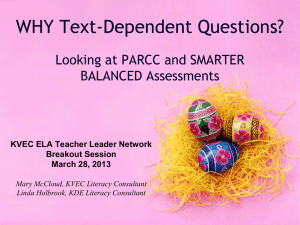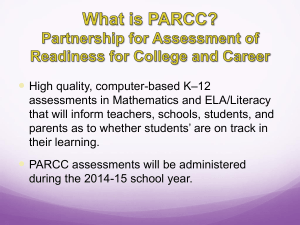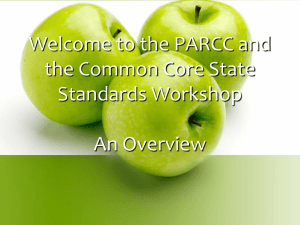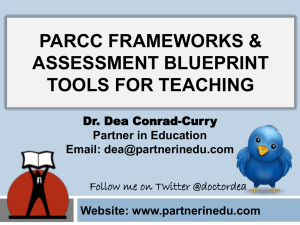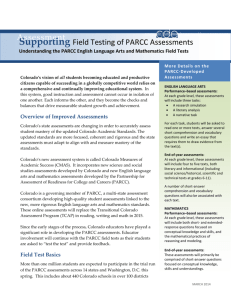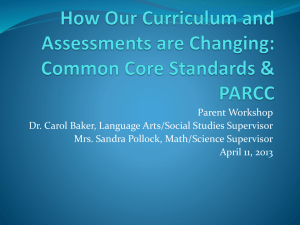TCAP, PARCC,COS, Soc.Stud. and Sci. Assesments,MAP, DRA II
advertisement
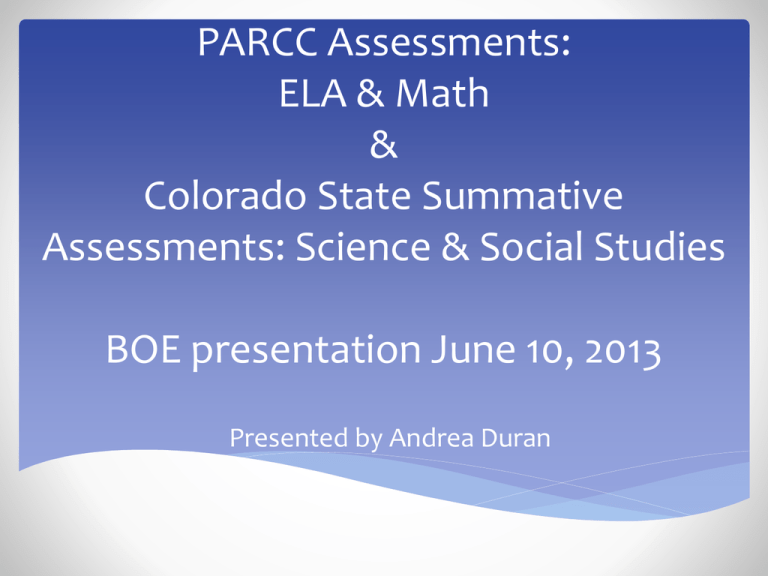
PARCC Assessments: ELA & Math & Colorado State Summative Assessments: Science & Social Studies BOE presentation June 10, 2013 Presented by Andrea Duran PARCC (Partnership for Assessment Readiness for College and Career) Info ELA & Math grades 3-12 End-of-year assessment for grades 3-11 in Spring 2015 End-of-year assessment for grade 12 in Fall of 2015 Fully electronic including writing assessments Aligned with Common Core Standards, not CAS Districts will have the option to use interim assessments in Sept. and Dec. in addition to Spring A Strong Foundation: The Common Core State Standards The Common Core State Standards in English language arts/literacy and mathematics were created by educators around the nation. Nearly every state in the nation is working individually and collectively to improve its instruction and assessments to ensure students graduate with the knowledge and skills most demanded by college and careers. 5 Using Technology to Advance Assessment and the Shifts Technology enhancements supporting accessibility (e.g., the ability to hover over a word to see and/or hear its definition, etc.) Transformative formats making possible what can not be done with traditional paper-pencil assessments (e.g., simulations to improve a model, game-like environments, drawing/constructing diagrams or visual models, etc.) Getting beyond the bubble and avoiding drawbacks of traditional selected response such as guessing or choice elimination. 11 Using Technology to Advance Assessment and the Shifts Capturing complex student responses through a device interface (e.g., using drawing tools, symbol palettes, etc.) Machine scorable multi-step tasks are more efficient to administer and score. 12 Overview of Mathematics Task Types PARCC mathematics assessments will include three types of tasks. Task Type Description of Task Type I. Tasks assessing concepts, skills and procedures • • • • Balance of conceptual understanding, fluency, and application Can involve any or all mathematical practice standards Machine scorable including innovative, computer-based formats Will appear on the End of Year and Performance Based Assessment components II. Tasks assessing expressing mathematical reasoning • Each task calls for written arguments / justifications, critique of reasoning, or precision in mathematical statements (MP.3, 6). Can involve other mathematical practice standards May include a mix of machine scored and hand scored responses Included on the Performance Based Assessment component III. Tasks assessing modeling / applications • • • • • • • Each task calls for modeling/application in a real-world context or scenario (MP.4) Can involve other mathematical practice standards. May include a mix of machine scored and hand scored responses Included on the Performance Based Assessment component 13 For more information see PARCC Item Development ITN Appendix D. Elementary Math Sample http://www.ccsstoolbox.com/parcc/PARCCPrototype_ main.html PARCC’s Core Commitments to ELA/Literacy Assessment Quality Texts Worth Reading: The assessments will use authentic texts worthy of study instead of artificially produced or commissioned passages. Questions Worth Answering: Sequences of questions that draw students into deeper encounters with texts will be the norm (as in an excellent classroom), rather than sets of random questions of varying quality. Better Standards Demand Better Questions: Instead of reusing existing items, PARCC will develop custom items to the Standards. Fidelity to the Standards (now in Teachers’ hands): PARCC evidences are rooted in the language of the Standards so that expectations remain the same in both instructional and assessment settings. 17 Students’ Command of Evidence with Complex Texts is at the Core of Every Part of the Assessment! SO. . . Two standards are always in play—whether they be reading or writing items, selected-response or constructedresponse items on any one of the four components of PARCC. They are: Reading Standard One (Use of Evidence) Reading Standard Ten (Complex Texts) 23 Three Innovative Item Types That Showcase Students’ Command of Evidence with Complex Texts • Evidence-Based Selected Response (EBSR)—Combines a traditional selectedresponse question with a second selected-response question that asks students to show evidence from the text that supports the answer they provided to the first question. Underscores the importance of Reading Anchor Standard 1 for implementation of the CCSS. • Technology-Enhanced Constructed Response (TECR)—Uses technology to capture student comprehension of texts in authentic ways that have been difficult to score by machine for large scale assessments (e.g., drag and drop, cut and paste, shade text, move items to show relationships). • Range of Prose Constructed Responses (PCR)—Elicits evidence that students have understood a text or texts they have read and can communicate that understanding well both in terms of written expression and knowledge of language and conventions. There are four of these items of varying types on each annual performance-based assessment. 24 End-of-Year Assessment (Grade 3): “How Animals Live” http://www.parcconline.org/samples/engli sh-language-artsliteracy/grade-3-ebsr-endyear-assessment 25 Understanding the End-of-Year Assessment Students will be given several passages to read closely. EBSR and TECR questions will be sequenced in a way that they will draw students into deeper encounters with the texts and will result in thorough comprehension of the concepts to provide models for the regular course of instruction. Will draw on higher order skills such as critical reading and analysis, the comparison and synthesis of ideas within and across texts, and determining the meaning of words and phrases in context. 26 Grade 3 Evidence-Based SelectedResponse Item #1 Part A Part B What is one main idea of “How Animals Live?” Which sentence from the article best supports the answer to Part A? a. a. “Animals get oxygen from air or water.” There are many types of animals on the planet. b. Animals need water to live. c. There are many ways to sort different animals.* d. Animals begin their life cycles in different forms. b. "Animals can be grouped by their traits.”* c. "Worms are invertebrates.” d. "All animals grow and change over time.” e. "Almost all animals need water, food, 29 oxygen, and shelter to live." Colorado State Summative Assessment for Science and Social Studies Begins April 25, 2014 Social Studies Grades: 4, 7, 12 (Fall) Science Grades: 5, 8, 12 (Fall) Colorado Academic Standards aligned & CoAlt available May 2013, release of frameworks indicating percent and number of score points for standard areas & assessment Pearson awarded contract Check out sample test items: http://www.pearsonaccess.com/cs/Satellite?pagename=Pe arson/QuickLink/co Student View of TestNav Tool bar Question # Section Review Flag QuickNav Navigation TestNav Tools •Pointer •Ruler •Eraser •Calculator •Highlighter •Periodic Table •Eliminate Choice (grade 8 science only) •Note Pad •Pencil •Magnifier •Help (science only) Colorado Summative & Alternate Assessments for Science and Social Studies Sample Item http://www.pearsonaccess.com/cs/Satellite?c=Page&c hildpagename=Colorado%2FcoPALPLayout_v2&cid=12 05794393662&pagename=coPALPWrapper Thank you for your time and attention! Contact me with any questionsaduran@esdk12.org

